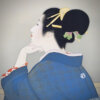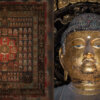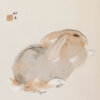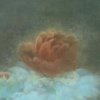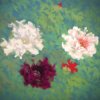History of Ukiyo-e (Japanese Genre Pictures)
Contents
Birth of Ukiyo-e (Japanese genre pictures)
Here are accounts for history of ukiyo-e, how it was born and developed to be spread around the world as one of the popular cultures.
Ukiyo-e from the Age of Provincial Wars to the early Edo Period before Hishikawa Moronobu Appeared
Ukiyo-e is a kind of genre pictures which reflect views of times being such as “living”, “manners and customs,” “fashion”. It is difficult to define it exactly so that some different opinions how and when it was born has arisen among the researchers.
“Iwasa Matabei” is said to be the most possible pioneer of ukiyo-e among the all other possibilities, which has been judged by the many researchers. Iwasa Matabei was born as a son of Araki Murashige who was a famous warlord in the age of provincial wars. Although the Araki lineage was destroyed by “Oda Nobunaga” because Araki Murashige raised a rebellion to Nobunaga, only Iwasa Matabei was rescued by his nanny and hided in Ishiyama Hongan-ji Temple so as to survive.
Afterward, he served “Oda Nobukatsu” as one of “Otogishū” (conversation partners of their masters) and became a painter in Kyoto after Oda Nobukatsu underwent “kaieki” (punished by being deprived of his fief, mansion and rank).
Ukiyo-e around that time being was not prevailed in Edo yet but mainly produced in Kyoto. And the ukiyo-e there were not printed by woodblock but produced just by original painting one by one.
Hishikawa Moronobu Appeared
Hishikawa Moronobu is thought to be the one who established ukiyo-e as an independent genre of arts. Hishikawa Moronobu created ukiyo-e not only by original paintings but focusing on woodblock prints principally.
While the original painting was expensive because it was not copiable but just the production one by one, the woodblock print made the copy possible to be mass-produced so that the price could lower. Consequently, commons got able to buy and enjoy ukiyo-e so that it could prevail as the popular culture explosively.
In addition, thanks to the emergence of the woodblock print technology, some people who earned their livelihoods only by producing ukiyo-e appeared, which means the ukiyo-e print artists became established as a profession.
Another advantage of the woodblock printed ukiyo-e was that the woodblock could become an asset. The publishers who owned the woodblocks were able to produce best-seller pieces of woodblock printed ukiyo-e more and more. And the publishers got to think of what kind of ukiyo-e gets best-seller and what type of ukiyo-e gets popular in future seriously.
Moreover, ukiyo-e painting artists could not feed themselves unless ukiyo-e they had drawn were sold. That was the reason why, they devoted themselves to research and develop their skills so that they could express their identities, which led to development of their techniques more and more, and opportunity to produce more splendid pieces of works.
In the meantime, ukiyo-e which was added the other colors by brush besides single-black-color painting called “Sumizuri-e” was produced out. Those ukiyo-e were called “Tan-e” and “Beni-e”.
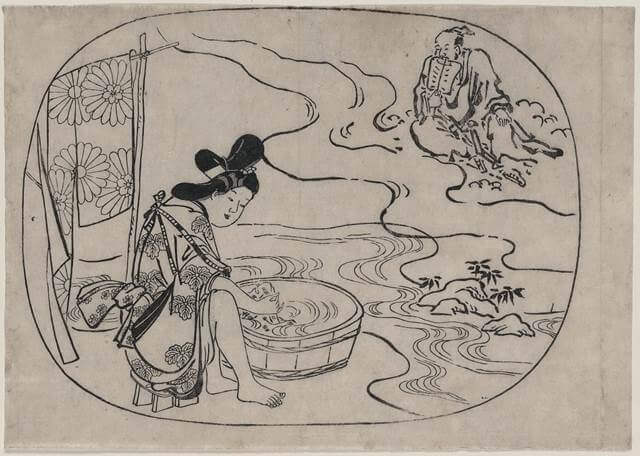
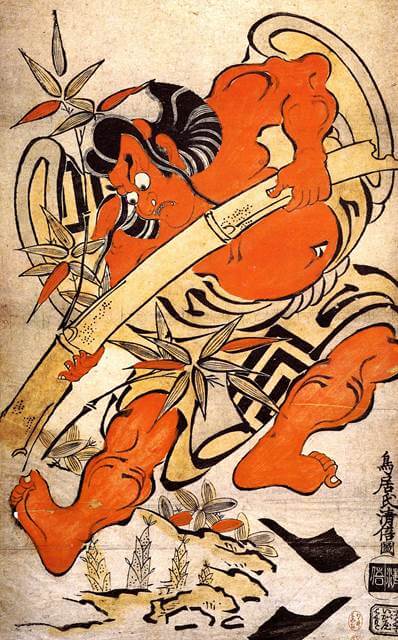
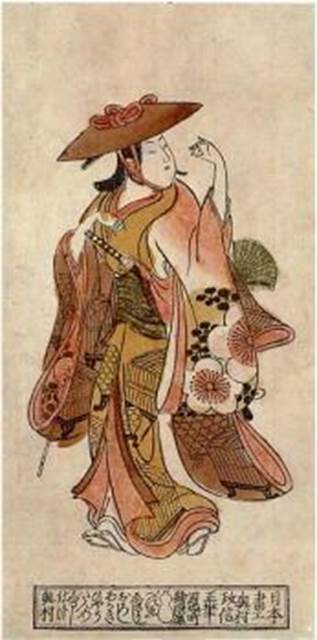
“Torii Kiyonobu” who was an ukiyo-e painting artist and later founded “Torii school” based on the painting style of Hishikawa Moronobu, left some Tan-e masterpieces including “Takii Hannosuke” (Figure of a famous kabuki actor).
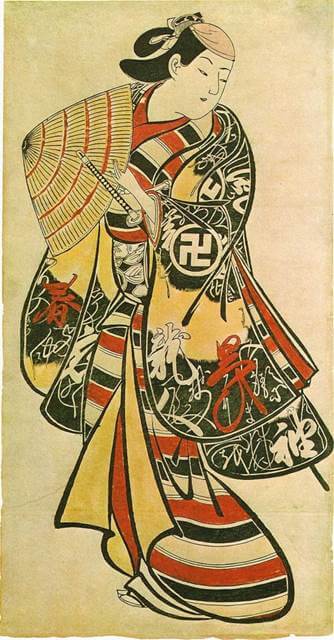
In the first half of the 18th century, “Benizuri-e” that was not added colors by brush later on but firstly made color-plates to add the colors by printing was born.
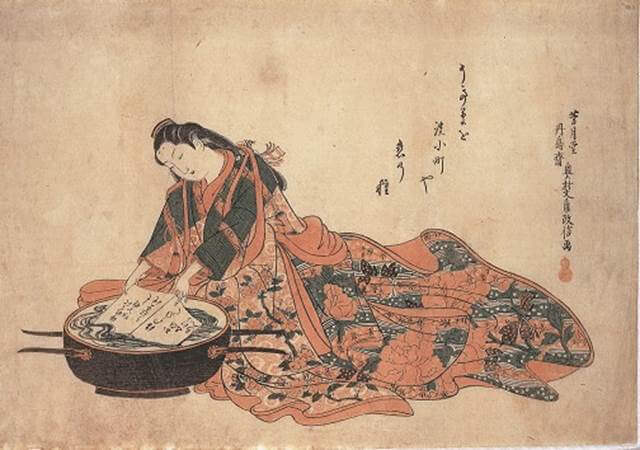
Benizuri-e, however, only 3 to 4 colors were available to be added so that the coloring expression could be to extent slightly better than Sumizuri-e.
Ukiyo-e Style from the Latter Half of the 17th Century to the Middle of the 18th Century
Although Hishikawa Moronobu drew “Bijin-ga” (portrait of a woman depicting her feminine beauties both apparently and internally) as well, his main works were focused on “Shunga” (pornographic painting) and “Meishoe” (painting of picturesque sceneries). Commons did not see entertainment places such as Yūkaku (licensed quarter) and Shibai-machi (town where playhouses stood) actually but just heard as the information by ears. Ukiyo-e, genre pictures realized those scenes with the reasonable prices so that it could get so popularity among the people.
“Okumura Masanobu” who was an ukiyo-e print artist and inspired by Hishiwaka Moronobu and Torii Kiyonobu produced pieces of ukiyo-e which depicted playhouses in detail adopting Western perspective. His pieces of ukiyo-e that express depth of the playhouses and realistic live feeling became much popular.
Flowering of Ukiyo-e
Ukiyo-e has become all the vogue as a popular culture and the technique of the production got improved steadily. Here are accounts for well-known ukiyo-e painting artists and their painting style in the flowering age as below.
Establishment of Division-of-Work System
Until the middle of the 18th century, Beni-e that was put out with a couple of colorings by brush onto Sumizuri-e was developed to Benizuri-e that was put out adding colors by the printing technology. From this time being, a division-of-work system that was processed by painters, sculptors and printers separately was established.
The Birth of Nishiki-e (Multi-Colored Woodblock Print)
In 1765, Ōkubo Jinshirō who was Hatamoto (direct retainer of the shogun) and Abe Hachinoshin developed a multi-colored printing technology in cooperation with Komatsuya Hyakki who engaged in a drugstore. This technology development should have not been realized without the technical improvements of the sculptors and woodblock printers.
These pieces of ukiyo-e looked gorgeous as Nishiki Orimono (brocade textile) so that they became called “Nishiki-e”. In order to bring out the much more fascination of Nishiki-e, the publisher asked “Suzuki Harunobu” for drawing the sketches. Pieces of ukiyo-e drawn by Suzuki Harunobu was richly colorful and highly expressive so that they prevailed among commons and he became the great successful person with Nishiki-e consequently.
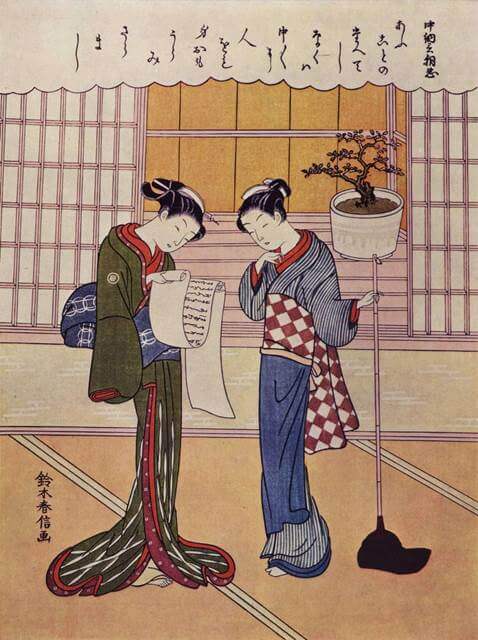
Nishiki-e did not only realize the richly colorful painting but also do the cost down so that it could be around JPY400 per piece at the current money value. That was the reason why it could be popular and prevail among commons.
Kitagawa Utamaro and Tōshūsai Sharaku Appeared
Despite Suzuki Harunobu spread Nishiki-e to commons, he passed away only a few years after Nishiki-e was born. Commons were looking for any new ukiyo-e painting artists appearing subsequent to Suzuki Harunobu. “Kitagawa Utamaro” and “Tōshūsai Sharaku” were the ones who appeared in the meantime.
Unlike Suzuki Harunobu, “Bijin-ga” (portrait of a woman depicting her feminine beauties both apparently and internally) Kitagagawa Utamaro drew zoomed in upper bodies of women so that their faces could look expressively. His Bijinga was called Ōkubi-e (close-up portraits of beautiful women) and expressed inner beauty of women by the looks. That could be the reason why, the painting style got much popular.
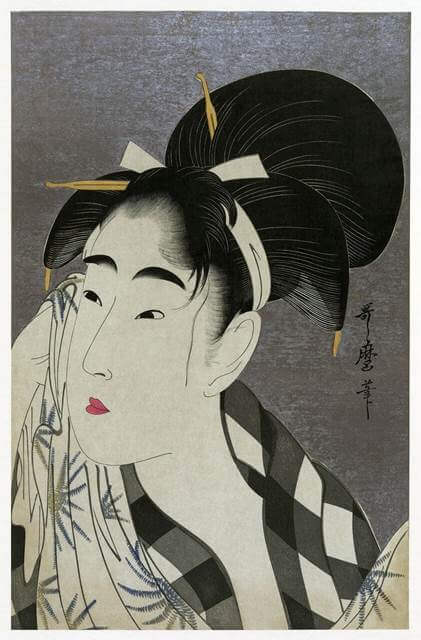
On the other hand, Tōshūsai Sharaku focused on “Yakusha-e” (ukiyo-e print of kabuki actors) to draw his pieces of works. The looks of Yakusha-e drawn by Tōshūsai Sharaku were deformed to easily understand the expressions. This deformation brought about a great impact on commons and much popularity in the public.
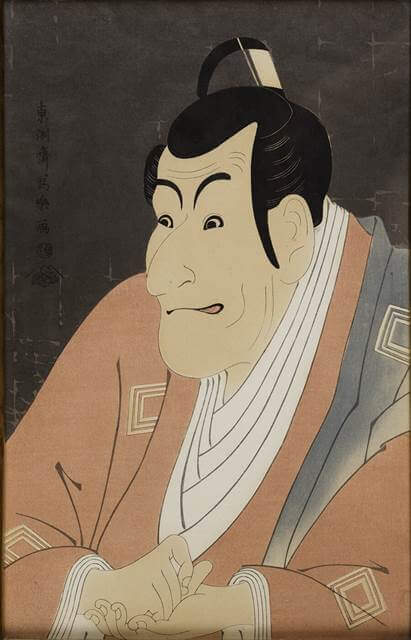
For your information, because of too short period Tōshūsai Sharaku was active around 8 months, various speculations have been made about his real identity and the topic still attract attention even today.
In addition, the existence of the publishers should not be forgettable. A publisher named Tsutaya Jūzaburō discovered the talent of Kitagawa Utamaro who might bogged down in so tough circumstances to sell his pieces of works, and thought up Ōkubi-e to put the works on the market. Tsutaya Jūzaburō was also the one who had Tōshūsai Sharaku draw Yakusha-e in order to shore up the sluggish Kabuki world at the box office.
Whether ukiyo-e painting artists brought in or not depended on how the publishers promoted the artists and their pieces of works. That was very important point so that their roles might resemble today’s comprehensive producers.
Summary of Painting Styles Around the Flowering Age of Ukiyo-e
Bijin-ga became more popular taking the birth of Nishiki-e as the opportunity. This is because it is said that the gorgeous coloring of Nishiki-e could fit to Bijin-ga.
Next to Bijin-ga, Yakusha-e also became popular. Thanks to Nishiki-e production style that enabled the paintings richly colorful and more expressively, portraits that drew the looks could attract people’s hearts. In order to catch onto the popularity of those movements, number of ukiyo-e painting artist who focused on faces and upper bodies such as Ōkubi-e was increasing.
Ukiyo-e in the Late Edo Period
In the latter half of the Edo period when the flowering age of ukiyo-e passed and no longer any novelty was found in Bijin-ga and Yakusha-e, some new movements were born. Here are accounts for the painting styles and the painters in the period as below.
Katsushika Hokusai and Utagawa Hiroshige Appeared.
Although Bijin-ga and Yakusha-e were keeping on the production, they came to deadlock because no longer any freshness was found in the styles. “Katsushika Hokusai” and “Utagawa Hiroshige” were newcomers appearing in the scene.
Initially, Katsushika Hokusai drew Yakusha-e. Afterward, he studied painting style of Kanō school and Western painting, which let him establish his own style eventually. “Thirty-six Views of Mount Fuji” became popular among commons and the catalyst to create a boom of the landscape painting. It is said that the number of people traveling rapidly increased after glancing at Meishoe (painting of picturesque sceneries) drawn by Katsushika Hokusai.
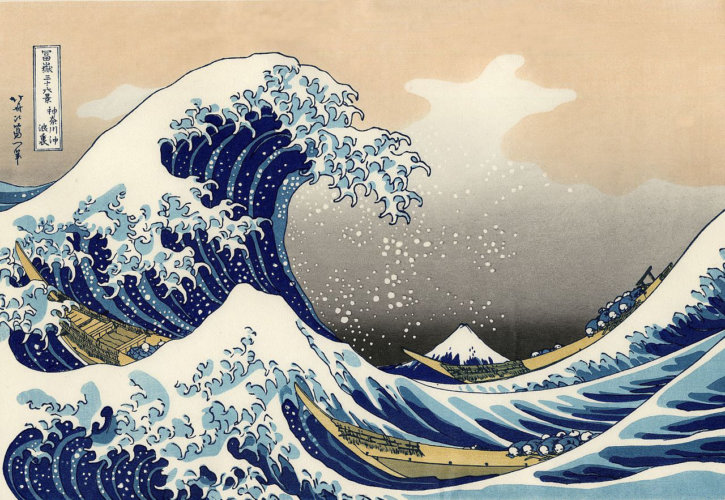
Utagawa Hiroshige also drew artworks or illustrations initially. Afterward, he was getting interested in landscape paintings and produced “Fifty-three Stages of the Tōkaidō”.
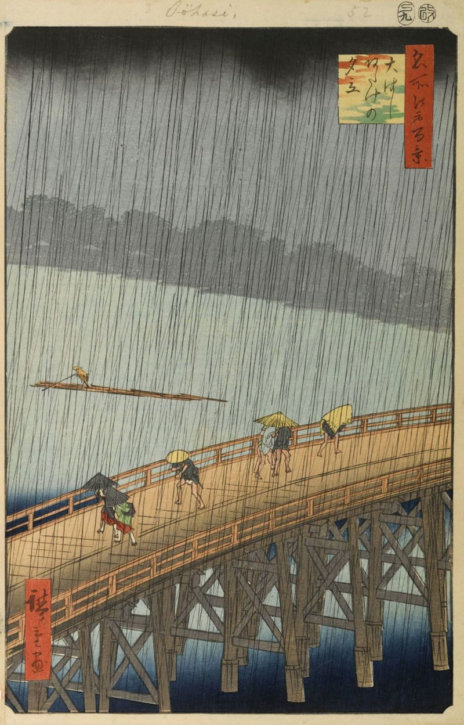
Landscape paintings drawn by Utagawa Hiroshige express the sceneries that depict the brimful sense of the seasons beautifully.
At that time, another one notable ukiyo-e painting artist appeared, that is “Utagawa Kuniyoshi”.
Despite Utagawa Kuniyoshi drew Yakusha-e for trying to make his figure in the world, he bogged down to be breakthrough somehow. However, once he worked on series of the “Shui Hu Zhuan” (Water Margin)”, he got great popularity explosively so as to bring about a boom of Shui Hu Zhuan.
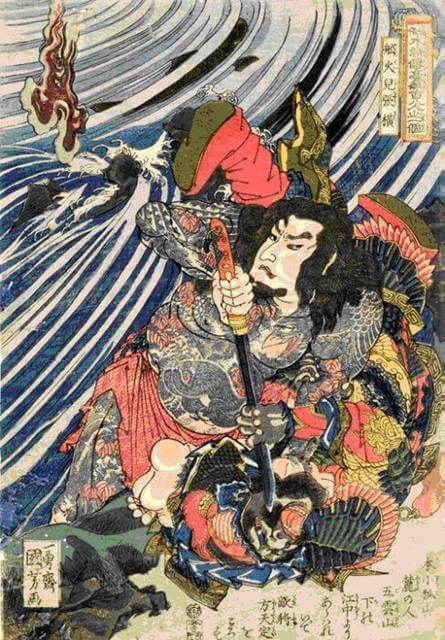
Afterward, he produced one work after the next in various genres of ukiyo-e. Especially, his sense of humor in caricature was unrivaled by other ukiyo-e painting artists.
Summary of Ukiyo-e Painting Styles in the Late Edo Period
Bijin-ga and Yakusha-e which became popular thanks to the birth of Nishiki-e began to decline, and landscape paintings became more popular alternatively. Landscape paintings drawn by ukiyo-e painting artists including Katsushika Hokusai, Utagawa Hiroshige and Utagawa Kuniyoshi drove the boom. Eventually, the number of ukiyo-e painting artists who drew landscape paintings increased.
Modern Ukiyo-e
After opening the door to the modern times, photography technology was brought in Japan. Here are accounts for the influence of photography to ukiyo-e and ukiyo-e painting artists who contributed to hold modern ukiyo-e up.
From the Decline of Ukiyo-e to the Reconstruction with New Printing Method
After a long national isolation policy ended up, photography technology brought in Japan along the Meiji era came out. The photography could be an alternative expression way to the role that ukiyo-e had played until then. Since it was higher reproducible than ukiyo-e and able to put out in a short time so that commons gradually moved away from ukiyo-e and onto the photography.
In addition, the other printing technologies that enabled cheaper production than Nishiki-e such as lithograph and copperplate print came out. That was also one of the backgrounds and reasons why ukiyo-e declined.
The reconstruction of ukiyo-e from its decline was achieved by the New Print Movement initiated by “Watanabe Shōzaburō” in the Taishō era. The New Print was aimed at production of ukiyo-e which was much more creative as well as different from photography with an emphasis on artistry although its printing methodology was same as the woodblock printed ukiyo-e.
In addition, they facilitated the division-of-work system more and acquired higher technique so that more expressive and artistic ukiyo-e than ever before was able to be realized.
The representative painters who played the great roles in the New Print Movement were Itō Shinsui, Kawase Hasui and Hashiguchi Goyō.
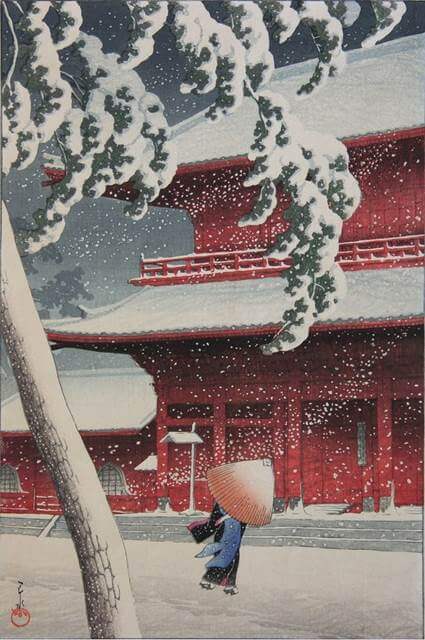
Ukiyo-e Painting Artists of Utagawa School, Who Contributed to Hold Modern Ukiyo-e up
It is not too much to say that, the ukiyo-e world from the Meiji Restoration to The New Print Movement was just worked out by ukiyo-e painting artists of Utagawa school. “Toyohara Kunichika” was the one who was active as a painter for Yakusah-e after the Meiji Restoration.
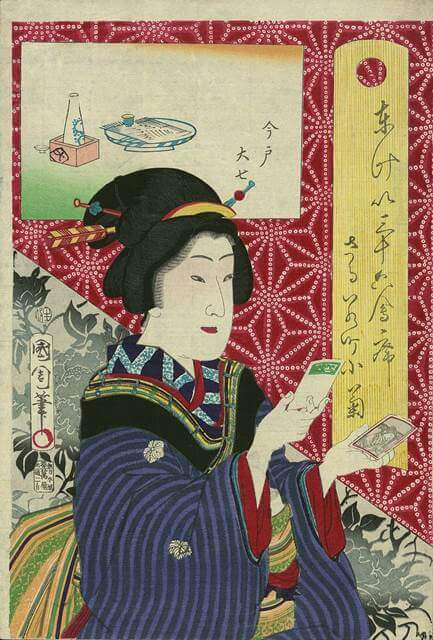
“Kobayashi Kiyochika” was evaluated as “The last ukiyo-e painting artist” and “Utagawa Hiroshige appeared in Meiji era”. He assimilated the Western style depiction into the ukiyo-e and aimed at establishment of a new Nishiki-e.
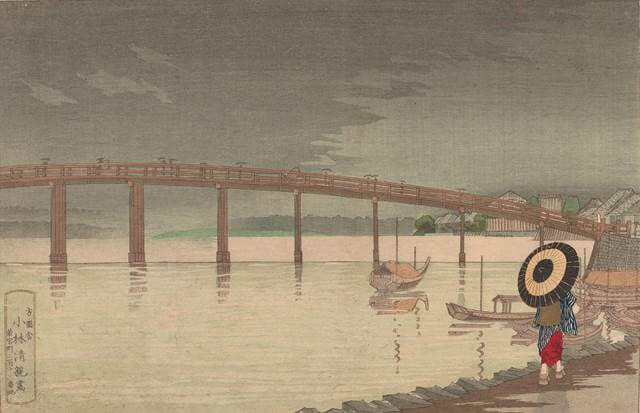
Ukiyo-e as Artworks
Ukiyo-e, which had been a something familiar to commons was being regarded as an artwork along the tendency that its artistry was highly evaluated in the West came out. Some Western painters, especially Impressionist painters, were greatly influenced by the rich coloring and elaborate techniques of ukiyo-e, and assimilated the elements of ukiyo-e into their works.
In addition, the New Print Movement that took place in the Taishō era in Japan pursued production of higher artistic ukiyo-e. Eventually, ukiyo-e might get some distances from commons while it was recognized as an artwork.

